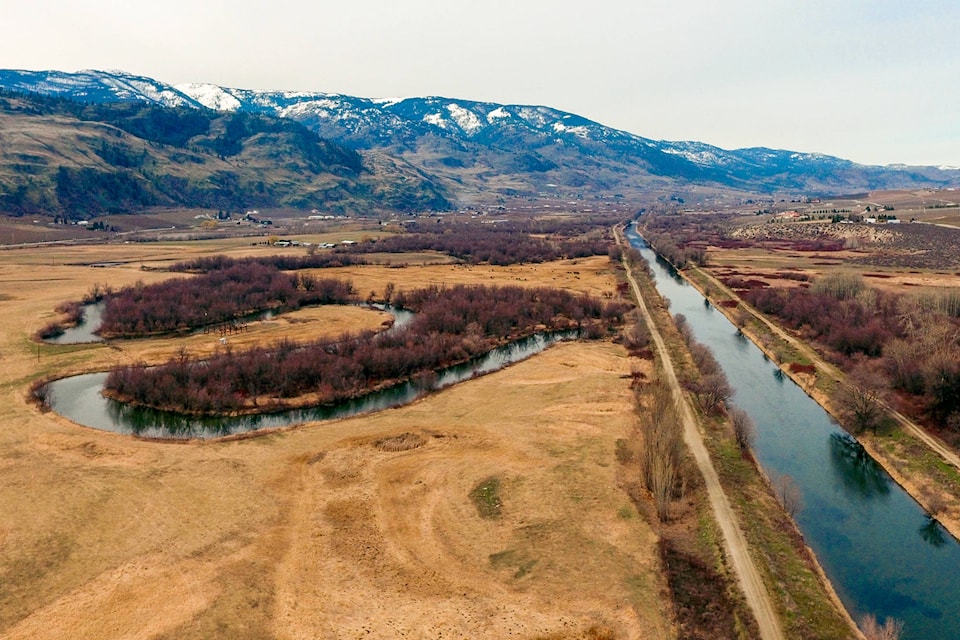Over the last century, wetlands in B.C. have been disappearing at an astonishing rate.
“Here in the South Okanagan, so many wetlands have been lost. We estimate that there is probably less than 15 per cent of the original wetlands remaining in the valley,” said Barb Pryce, Southern Interior program director for the Nature Conservancy of Canada.
Thanks to the efforts of the Nature Conservancy, in partnership with Ducks Unlimited Canada, another piece of wetlands is being preserved.
A 90-acre (36.4-hectare) wetland property in the heart of one of British Columbia’s best birding areas. Located along the Okanagan River in an expanse of wetland known as the Osoyoos Oxbows, the new conservation area is the latest addition to a complex of conservation lands that parallel Highway 97 between Osoyoos and Oliver.
“As far as birds, it is a real magnet,” said Richard Cannings, biologist, birder and NDP MP for South Okanagan West Kootenay. He says the area is known as one of the top 10 birding locations in B.C.
“You will find birders from all over the continent along that road through the spring and the summer. It’s so tremendous and those wet meadows are a big part of that. They are a habitat you don’t find many places, and certainly not in a public access situation.”
Conserving the oxbows area is important for more than drawing birders.
“These are very precious lands for wildlife and the ecosystem in general,” said Cannings. “Conservation groups have been looking at those types of properties as long as I can remember.”
Pryce said the wetlands are vital for preserving biodiversity in the South Okanagan.
“They’re unique, they’re rich in nutrients, their ecosystems are very biodiverse and they are one of our most important conservation targets,” said Pryce. “They are really considered hot spots of species diversity.”
There are benefits for the human population too. Wetlands filter water and help promote beneficial species.
“If we have healthy wetlands, we have a healthy bat populations and bird populations and they will eat insects that people might not be as keen on, such as mosquitoes,” said Pryce.
The property contains some of the last remaining marshes in an area that was once a significant chain of wetlands. Notable birds found in this area include the only breeding population of bobolinks in the Okanagan Valley, long-billed curlew and yellow-breasted chat. All of these species have been designated species at risk by the Committee on the Status of Endangered Wildlife in Canada.
“This project builds on our prior investments and adjacent projects such as the Bobolink Meadows project, where Ducks Unlimited Canada and our partners secured and restored some of the former oxbow floodplain wetlands,” said Dan Buffett, manager of provincial operations for Ducks Unlimited. “This project brings DUC, our partners and the community closer to a vision of restoring the full function of these wetlands.”
Pryce said the next step is to develop a property management plan, part of which will be a restoration plan, in co-operation with Ducks Unlimited.
“It’s been used for a long time for haying, for agricultural production. You can still see some of the old remnant of oxbows from the Okanagan River before it was channelized,” said Pryce.
Similar restoration work was done on a nearby property, on the south side of Road 22, where some of the oxbow remnants were excavated and native species were planted alongside.
The water filled in quickly, and by the next morning, there was a little pond.
“It was just amazing to see how quickly we were able to bring water back into the system. We even had waterfowl landing on these newly created water bodies within days,” said Pryce.
“Wetlands can be resilient. If they are brought back through restoration efforts, oftentimes it will happen quicker than people think. They do want to thrive and revert back to their natural condition if they are given an opportunity.”
Pryce expects some of the hayfields will be retained, since some of the species curlews and bobolinks rely on the meadows and overgrown fields for part of their life cycle.
“We will be creating a mosaic of habitat types on the property,” said Pryce.
Pryce was also quick to point out this acquisition didn’t happen without funding partners, including the Government of Canada through the Natural Areas Conservation Program, Habitat Conservation Trust Foundation, B.C. Conservation Foundation, Oliver-Osoyoos Naturalists’ Club, South Okanagan Naturalists’ Club, Okanagan Similkameen Parks Society, Burrowing Owl Winery and many individuals.
“Our partners are from here and they are from other areas as well. I think that is really strong recognition of how important the securement of this Osoyoos Oxbows property is,” she said.
Cannings said the previous federal government did a good job of investing with the Nature Conservancy and other groups, and he hopes the Trudeau Liberals bring it back up to previous levels.
“I think this is a very good investment. If we want to have good functioning ecosystems, clean environments, we have to preserve these natural spaces that have so many functions for us,” said Cannings.
